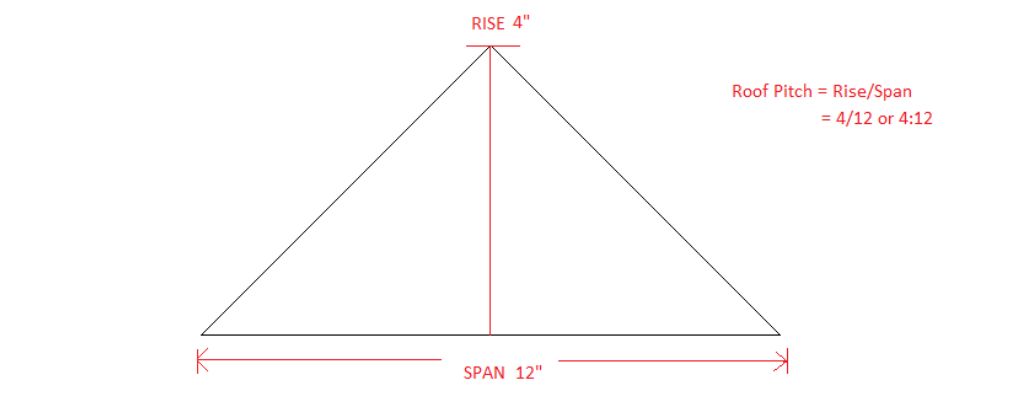The roof pitch is often mistaken for the roof slope, but the distinction is important, especially if you are a homeowner or someone looking for a roof replacement project. The roof pitch isn’t just an aesthetic feature. It affects your home, its renovation scope, and your budget to a great extent.
At Division Kangaroof, we help homeowners learn more about their roofing and exterior choices so they can make more informed decisions. In this blog, we will explain what a roof pitch is, how to calculate it, and everything that depends on the pitch.
What Is Roof Pitch?
A roof pitch is the ratio of a roof’s height to its width, in inches. You can calculate it by dividing the roof’s rise by the span. The diagram below illustrates the calculation of a roof pitch with a 4-inch rise and 8-inch span.
There are many ways in which roof pitch affects you and your home. It even impacts your future home improvement projects and the budget. We will now explain the crucial details for homeowners and designers that are looking to replace a roof or renovate a house.

Roof Pitch Determines The Ideal Roofing Material
There are three main categories of roof pitches which represent how steep your roof is. These pitches are low, moderate, or high. The type of roofing material you’ll need for a replacement project depends on the steepness of your roof.
Low Roof Pitch: 1/12 to 3/12
Low-pitch roofs are common on cabins, shacks, and commercial buildings. On high-rise buildings, low-pitched roofs usually appear flat from afar. Below are examples of materials ideal for flat and low-pitched roofs:
- Single-ply roofing membranes such as EPDM, TPO, and vinyl.
- Built-up roofing (BUR).
- Standing seam metal panels.
- Clay or cement tiles.

Moderate Roof Pitch: 4/12 To 9/12
Most homes have a roof pitch between 4/12 and 9/12. A moderate roof pitch is easy to work with, looks appealing, and is more weather-resistant than low-pitched roofs. They are better at holding roofing material like:
- Organic shingles: asphalt and clay.
- Composite shingles: 3-tab, architectural, and luxury.
High-Pitched Or Steep Roofs: Over 9/12 or 39.5 degrees
High roof pitches are popular among homeowners who live in icy locations or people who want to create unique exteriors or roof designs. You may also find churches and some commercial buildings with steep roofs made of slate, stone, or wood shakes. These are the ideal roofing materials to cover a steep roof.
Lower Roof Pitch Allows Solar Panels To Get More Sunlight
The pitch or steepness of your roof affects how much sunlight your solar panels receive. As the pitch goes lower, the roof plane becomes flatter. A flatter roof allows for solar panels to receive more sunlight during the day, enabling more energy production. Hence, flat roofs and roof pitches up to 4/12 are better for solar panels. If you live in regions that are warm or receive plenty of sunlight, you can utilize a low or medium-pitched roof to power the solar panels and generate maximum energy!
High-Pitched Roofs Can Save Your Home From Snow And Water Damage
Roof pitch is essential in determining how fast rainwater and snow will drain into the gutters. As the pitch rises, the roof plane becomes steeper, allowing everything to slide off the roof more quickly. However, a lower roof pitch means piles of snow and ice dams can accumulate on your roof. If you live in an area that receives heavy rain and snowfall every year, you’ll want a high-pitched roof to prevent overnight leaks and hidden water damage from occurring.
Pitched roofs also allow for greater ventilation in your home due to a gap between the pitched roof and the flat interior roof of your home. This allows for heat to flow easily out of your home in the summer, and you can choose to add insulation into the gap for greater energy efficiency.

Roof Pitch Determines How Much Attic Space You Need
If you don’t need a huge amount of attic space or an extra room upstairs, then low-pitched roofs are great! Generally, a low roof pitch improves air circulation and reduces extra moisture in the air, making it a good option for warm and humid climates.
If you want more space in your house without having to add an entire story to your home, utilizing a high-pitched roof is your best option. This will create additional space that has a lot of potential and can be used not only for storage but as an office or playroom as well.
Moderate Roof Pitches Are Excellent For Festive Decorations!
It’s common for homeowners to dress up their homes during the holiday season with festive lights and decorations. Utilizing higher-pitched roofs for these occasions allow your neighbors to see your tastes and hard work, as they provide a more appealing aesthetic.

There Are Three Ways To Find Your Roof Pitch
Before you think about climbing up a ladder, make sure you look at the blueprints of your home if they’re available. Almost every blueprint of a house has the roof pitch written by the architect, builder, or roofing contractor.
If you cannot find the documents or design, there’s also a second way to know your roof pitch. Check if your smartphone has a gyroscope, or download any roof pitch calculating app compatible with your device. Make sure the app has a good rating and that you follow the instructions. This tool may not be entirely accurate, but you can use it to get a rough estimate.
The most reliable and accurate method to know your roof pitch is to simply ask a local roofing contractor for a free roof inspection. Finding the exact roof pitch measurement requires safety gear, professional tools, good experience, and accuracy.
If you have any questions about your home’s roof pitch or want to know which one will work best for your home, we can help you.
Discuss Roof Pitch And More With Our Experts
At Division Kangaroof, we have a reliable team with years of roof replacement experience. Like a roof’s pitch, there are many important things to consider before getting a new roof. Before you make up your mind about that pitch, roofing material, or ventilation system, it’s always best to have expert advice on the matter. To help all homeowners, we offer free roof inspection and consultation. We’ll send our best expert to calculate your roof pitch and answer all your questions regarding different parts of a roof. Call us at (706)-778-3516, and we will be happy to help with your roof replacement project.


